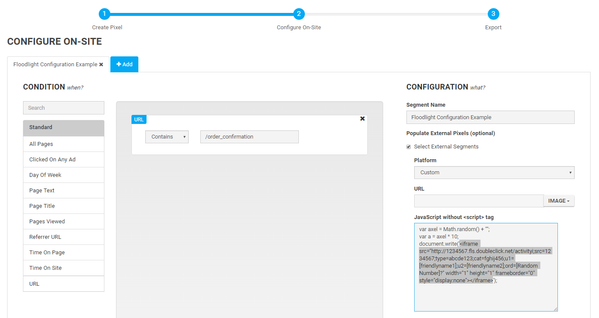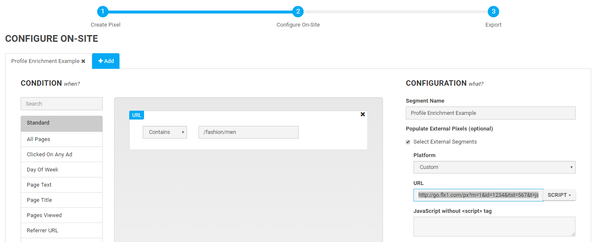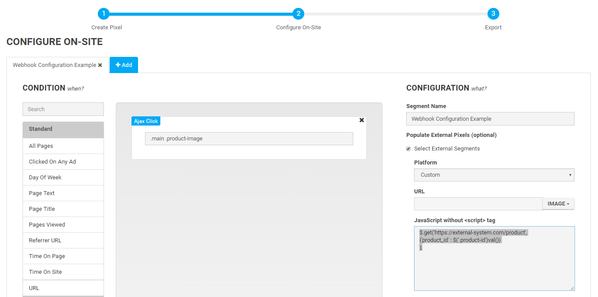Trigger External Pixels
This entry provides detailed information on how to trigger external pixels.
| Contents of the Table |
|---|
Use Cases
When creating a segment or conversion it is also possible to trigger external pixels as an optional configuration setting. All type of pixels (e.g. image url, script, etc.) are supported and can be piggybacked onto the corresponding Custom (Success) Event. The term piggybacking usually refers to the situation where the firing of pixel A causes the firing of pixel B. This second firing can either be via a redirect or a server-side firing.
- Conversion Tracking: Track conversions in 3rd party platforms like an ad server or DSP to feed its attribution reporting or bidding algorithm.
- Retargeting Lists: Populate plain retargeting lists within a 3rd party platform like the Google AdWords tag for example.
- DMP Profile Enrichtment: Send and store custom attributes (i.e. labels) that cannot be captured on-site to enrich a user profile in the DMP.
- DMP Webhooks: Trigger both internal (DMP) and external webhooks based on specific on-site user behaviour.
Implementation
A step-by-step guide on how to configure an external pixel population:
Go to Data Collection and create a new pixel or configure an existing pixel.
Go to Configure On-Site page.
Add a Custom Event or Custom Success Event label.
Add the appropriate conditions for this Custom Event or Custom Success Event pixel to fire.
Tick the Select External Pixels box under the Trigger External Pixels (optional) item.
- Select Custom from the Platform dropdown.
- Include the 3rd party pixel URL or JavaScript code into the appropriate box.
DCM Floodlight Tag
This provides an example on how to piggyback a Doubleclick Floodlight Tag in order to track conversions in Google platforms (e.g. Doubleclick Campaign Manager). Note that this code must be considered as a template and can differ per implementation.
Google AdWords
This provides an example on how to piggyback a remarketing tag in order to populate a RLSA (Remarketing List for Search Ads) for Google AdWords. Note that this code must be considered as a template and can differ per implementation.
var google_conversion_id = 123456789;
var google_custom_params = window.google_tag_params;
var google_remarketing_only = true;
window.flx1_jQuery.getScript('//www.googleadservices.com/pagead/conversion.js')
This provides an example on how to piggyback a Facebook conversion tracking pixel that can serve as a basis for a Facebook Audience. Note that this code must be considered as a template and can differ per implementation.
!function(f,b,e,v,n,t,s){if(f.fbq)return;n=f.fbq=function(){n.callMethod?
n.callMethod.apply(n,arguments):n.queue.push(arguments)};if(!f._fbq)f._fbq=n;
n.push=n;n.loaded=!0;n.version='2.0';n.queue=[];t=b.createElement(e);t.async=!0;
t.src=v;s=b.getElementsByTagName(e)[0];s.parentNode.insertBefore(t,s)}(window,
document,'script','https://connect.facebook.net/en_US/fbevents.js');
fbq('init', '0123456789876543');
fbq('track', 'Purchase', {value: '5.00', currency:'EUR'});
(The init value should relate to the Facebook Pixel ID)
DMP Pixel
Besides populating a 3rd party pixel you can also send and store a custom attribute for this user in the DMP. As an example you can decide to add the label "male" in case a user visits a given webpage relevant to men. The latter should be specified within the Segment or Conversion configuration. Based on the principles as documented in the Trigger External Pixels entry you can use the following template:
Template
http://go.flx1.com/ia?m=1&id=1234&itst=567&data=%7B%0A%09%22key%22%3A%20%22value%22%0A%7D
- The "m" parameter reflects the static customer_id relevant to your DMP account.
- The "id" parameter reflects the relevant pixel_id.
- The "itst" parameter reflects the relevant segment or conversion id.
- The "data" parameter should contain the custom attribute in URL encoded JSON format.
Piggyback
This template can also be used to piggyback a DMP segment or conversion pixel onto a 3rd party pixel. The "data" parameter is optional in that case.
Webhooks
This feature can also be used to trigger a predefined webhook with either the DMP or another API-based system. An example of an external webhook can be found below. It illustrates how a given "Product ID" can be send to an external system after the user clicked on the product image.



